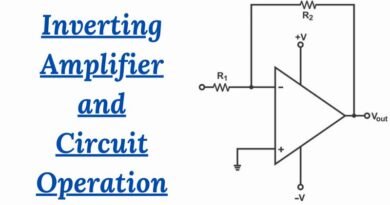Understanding Fuses: Types, Construction and Applications
The concept of the fuse dates back to the late 19th century, with Thomas Edison credited for its development. The early fuses were simple in design, yet they laid the groundwork for the sophisticated protective devices we use today. Over time, fuses have evolved to accommodate a wide range of applications, from household electrical systems to industrial machinery and advanced electronic devices.
In modern electrical engineering, fuses come in various types and ratings, each tailored to specific applications. The diversity in fuse designs allows for precise protection levels, ensuring that every circuit can be guarded against potential overloads or faults. Understanding the different types of fuses and their specific applications is essential for anyone involved in designing, maintaining, or troubleshooting electrical systems.
What is a Fuse?
A fuse is a safety device designed to protect electrical circuits from excessive current. It consists of a metal wire or strip that melts when too much current flows through it, thereby interrupting the flow of electricity. This melting action prevents overheating and potential fires, safeguarding both the device and the user.
Symbol of a Fuse
The Standard IEEE/ANSI symbols for the fuse is as follows:

Types of Fuses
Fuses can be broadly categorized into AC (Alternating Current) and DC (Direct Current) types, each further divided based on voltage levels and specific applications.

DC Fuses
DC fuses are generally larger and more complex in construction compared to AC fuses. This complexity arises due to the constant nature of DC voltage, which can lead to difficulty in breaking the circuit and a higher risk of electric arcs forming between molten wires. To mitigate this, DC fuses are designed with electrodes placed at greater distances.
AC Fuses
AC fuses are smaller and simpler in construction due to the oscillating nature of AC voltage, which reduces the likelihood of arc formation. AC fuses are classified into two categories: High Voltage (HV) and Low Voltage (LV) fuses.
Low Voltage (LV) Fuses
LV fuses are further divided into five main types:
- Rewirable Fuses: Commonly used in household wiring and small-scale applications. They consist of a fuse base and a fuse carrier, allowing easy replacement of the fuse wire.
- Cartridge Fuses: These fuses are enclosed in a container with metal contacts. They come in two varieties:
- D-Type Cartridge Fuses: Comprising a cartridge, fuse base, adapter ring, and cap, these fuses ensure circuit connection through contact with the conductor.
- Link Type Fuses: Known for their high rupturing capacity (HRC), these fuses use materials like porcelain and silica sand to control the arc generated when the fuse blows.
- Blade and Bolted Type Fuses: Designed for easy replacement, these fuses are commonly used in automotive and industrial applications.
- Striker Fuses: These fuses incorporate a mechanical device that trips or closes the circuit upon activation.
- Switch Type Fuses: Enclosed within a metal switch, these fuses are used for low and intermediate voltage levels.
High Voltage (HV) Fuses
HV fuses are used to protect transformers and power systems operating at voltages above 1500V. They include:
- Cartridge Type HRC Fuses: Featuring a helix-shaped fuse component to prevent corona effects at high voltages. They contain both low-resistance and high-resistance elements.
- Liquid Type HRC Fuses: Filled with a fluid such as carbon tetrachloride, these fuses use the liquid to extinguish arcs and are used for transformer protection.
- Expulsion Type Fuses: Designed for 11kV systems, these cost-effective fuses protect feeders and transformers by using gases generated during arcing to extinguish the arc.
Glass Fuses
Glass fuses offer the advantage of visibility, making it easy to check their status. They are typically used in applications with currents up to 15 amps. Common types include the AGC, AGU, AGW, and AGX series.
Characteristics of Fuses
Several critical factors must be considered when selecting a fuse for a specific application:
- Voltage Rating: Indicates the maximum voltage the fuse can handle.
- Current Rating: Represents the current the fuse can carry under standard conditions.
- I2T Value: The product of the square of the current and time, crucial for determining the energy let-through by the fuse.
- Temperature: The operating temperature impacts the current-carrying capacity of the fuse.
- Response Characteristic: Describes how quickly the fuse responds to overcurrent conditions (e.g., Quick-Acting, Time-Delay).
- Packaging Size: Ensures the fuse fits correctly within the circuit.
Advantages and Disadvantages of Electrical Fuses
Advantages
- Simple and reliable protection for circuits and wiring.
- Cost-effective and easy to replace.
- Available in a wide range of current and time ratings.
Disadvantages
- Manual replacement required after a fuse blows.
- Potential damage to components before the fuse interrupts the current.
- Complete interruption of power to the circuit when the fuse blows.
Applications of Electrical Fuses
Fuses are widely used in various applications due to their simplicity and reliability. They are essential in protecting home appliances, low and moderate voltage devices, and electrical systems from overcurrent and short circuits. Fuses also play a critical role in safeguarding cables, power circuits, and transformers.
Construction and Working Principle
A fuse typically consists of:

- Fuse Element: A metallic wire that melts when subjected to excessive current.
- Fuse Body: Encloses the fuse element.
- Fuse Caps or Terminals: Connect the fuse to the circuit.
- Fusible Link and Blowout Vent (in some cases): Enhance the fuse’s safety and performance.
The working principle of a fuse is based on the heating effect of electric current. When the current exceeds the fuse’s capacity, the metallic wire heats up and melts, breaking the circuit and stopping the current flow. The melted fuse can then be replaced to restore circuit functionality.
Why Do We Require Fuses?
Fuses are required to protect both electrical devices and users from potential hazards. When an electrical fault, such as a short circuit or an overload, takes place, the current can rise to dangerous levels. Without a fuse, this excessive current could cause severe damage to the wiring, appliances, and even pose a risk of fire. By blowing and cutting off the current, fuses ensure that the electrical system remains safe and functional.
Manufacturing Process of Fuses
The manufacturing process of fuses is a meticulous and highly controlled procedure, ensuring the end product is both reliable and safe. The process begins with the selection of high-quality raw materials. The primary materials include conductive elements such as zinc, copper, or silver for the fuse element, and insulating materials like ceramic, glass, or plastic for the fuse body.
The first step in the assembly line is the precision cutting of the fuse element. This step is critical, as the dimensions of the element must be exact to ensure proper functionality. Advanced machines are used to achieve the precise thickness and length required. Following this, the fuse element undergoes a series of treatments, including annealing, which enhances its durability and performance.
Next, the fuse body is prepared. Depending on the type of fuse being manufactured, the body might be molded from plastic or shaped from ceramic or glass tubes. The encapsulation of the fuse element within the body is a crucial phase. This involves placing the fuse element inside the body and securing it with end caps, typically made from metal. The method of encapsulation varies but is designed to provide a robust barrier against environmental factors that could affect the fuse’s performance.
Once assembled, the fuses undergo rigorous testing to ensure they meet industry standards and quality control measures. Tests include electrical performance evaluations, mechanical strength assessments, and environmental resilience checks. These tests are necessary to confirm that each fuse can reliably interrupt the circuit under fault conditions without causing further damage.
Quality control is an integral part of the manufacturing process. Each stage, from raw material selection to final testing, involves stringent checks to maintain the highest standards. Compliance with industry standards, such as those set by the International Electrotechnical Commission (IEC) or Underwriters Laboratories (UL), ensures that the fuses are safe for use in various applications.
Summary
In summary, fuses are indispensable components in electrical and electronic systems, providing crucial protection against overcurrent and short circuits. Understanding the different types, characteristics, and applications of fuses is vital for ensuring the safety and efficiency of any electrical system.








